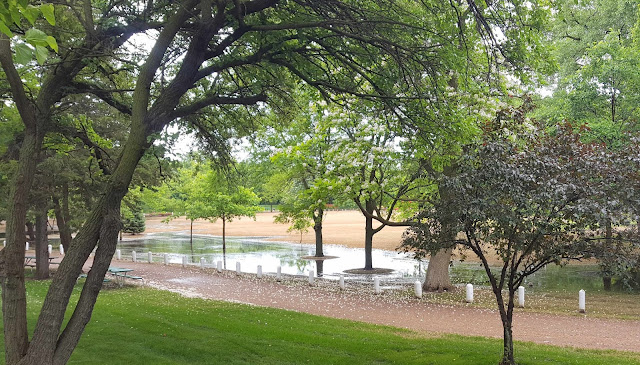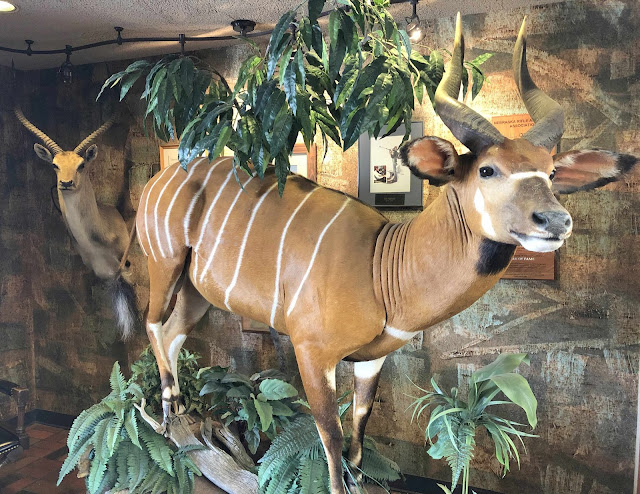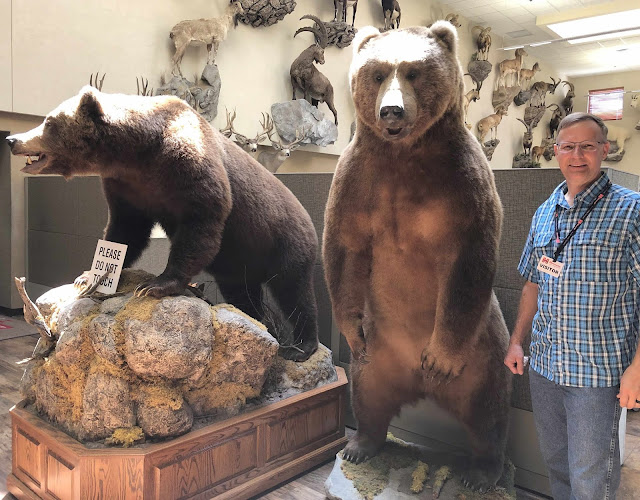No pictures were allowed on the tour so we have no pictorial evidence, but it was a good one! Our guide showed us around for 1.5 hours letting us touch and see up close the process of manufacturing the Kawasaki products. The picture below is a time line of all the different products introduced here at the Lincoln plant. They started making motorcycles, then grew into jet skis, ATVs, and mules. In the middle of the time line we found out that they also make passenger railroad cars. The final item in the bottom right corner is the latest project--doors for Boeing aircraft.
Our guide has worked for the company for twenty years, and he pointed out the new production line that would soon be making a top-secret new product. We'll have to be watching for that. We ended up in the makeshift museum that includes many of the products that have been built here over the years in Lincoln Kawasaki. That would include ATVs that range in size from two seaters all the way up to ones that can fit the entire family.
After that very interesting tour, we headed on down the highway west for another hour's drive to Grand Island, Nebraska. We settled into a very nice first-come-first-served camping spot at Hall Country Park.
Just like much of the midwest, they've gotten too much rain here in Grand Island. The playground and many of the low-lying picnic tables are under water. All that standing water means we also saw mosquitoes at this park.
After setting up in our camping spot, we headed to another factory tour at Hornady Manufacturing Company. Mark is already wearing his free souvenir Hornady cap outside the visitors' entrance with posts shaped liked bullets.
That's because they're in the business of making bullets here at Hornady. Again, no pictures allowed on the factory floor, but we could take as many as we wanted of the stuffed mounts in the lobby and office areas.
The founder was an avid hunter who couldn't find good quality bullets when he started the company in 1949. As you will see, the Hornady family puts those bullets to use on hunting trips all over the world.
Our tour guide took us right beside the machines that were pumping out 6 million bullets each day. We touched the shiny copper casings and watched as they poured the molten lead and then stretched it into bullet cores. It was a very interesting tour!
We're in the middle of farm country, so it's not surprising that our third tour was at Case Industries. We got to watch them assemble combines from the very beginning to the end of the line. Cameras were allowed, so we have pictures to prove we were on this tour.
Just like the other tours, we were provided protective eye gear. But at Case we were also given reflective vests, hard hats, and even steel-toed slip-ons that went over our shoes. They had a hard time finding some small enough for Denisa, but these little pink steel toes did the job.
We saw everything from the plates of steel that are laser cut by a computer generated program to get the most pieces from each piece of steel . . .
to the giant presses that curve and bend those flat pieces of steel into the unique dimensional pieces needed to make a combine.
Then we saw those metal pieces, fresh out of the paint shop as they are transported to where they were needed in the factory.
Our tour guide explained that it takes around 7,000 pieces to make these complicated combines. As we walked by the assembly line, we could see some of those thousands of pieces being put into place. While they make many of the pieces here, they get the engines from France, the cab wiring harness from Mexico, the radiators from Belgium . . .
Because it is so massive, the top half of the combine is assembled separate from the bottom half. In the picture below it is being hoisted up . . .
so it can be "married" to the lower section that is just now arriving after being completed in a different part of the factory.
We expected to only see red on this tour, but this plant also builds yellow New Holland combines. The people on the line have to be able to assemble both, as they use completely different parts. That yellow combine is going to cost more. One of the reasons is that the yellow New Holland cover on the right is metal, while the red Case cover on the left is molded plastic.
Our tour guide also explained the large boards overhead throughout the factory. 18 minutes and 19 seconds are left before each combine will roll forward to the next station. So workers know how much longer they have to get everything completed at their station. Also, 9 of the 13 scheduled combines had been completed so far by 3:21 p.m.
We watched as the giant blue robot arm brought the front tire into place so it could be bolted on in the final step. Then this new combine will see its first rays of sunshine as it is driven out of the factory.
We had to give back our stylish tour outfits, but our parting gift was this laser-cut company emblem showing just how intricately that machine can cut metal.
It was a very educational two days of factory tours, and we would recommend all three companies. The Case tour was over two hours long, and we walked well over a mile on that tour alone. We were tired from being on our feet so much. So we have great respect for the workers that stand and do tough jobs all day, every day. Hard hats off to the workers of Nebraska and their companies that made this fun factory tour trifecta possible!





















No comments:
Post a Comment